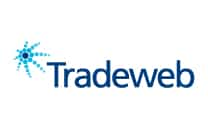
Charlie Campbell-Johnston, head of integration and workflow solutions, Tradeweb
What is the AiEX solution? Why did Tradeweb develop it six years ago?
Charlie Campbell-Johnston: AiEX is essentially the ability to trade directly from your order management system (OMS) to a set of pre-defined rules. It was developed initially to help address capacity issues faced by a large, real money client at times of high volume.
Typically, a Tradeweb user brings up a ticket, places dealers in competition, sends the orders to request for quote (RFQ), evaluates the responses, then hits or lifts the trade. AiEX allows the user to pre-configure a set of rules within Tradeweb, which are used to execute the order once it arrives from the OMS. This frees the buy-side trader to handle value-added flow, which needs more time and effort.
The tool has quickly scaled from smaller orders in the more liquid asset classes, to less liquid asset classes in larger size. This reflects the same dynamic on the sell-side where traders have used auto-quoting for some time, but the scope has increased markedly in recent months; AiEX allows the buy-side to auto-submit, effectively creating a mirrored workflow.
What is a typical AiEX workflow?
CCJ: Once an order is submitted, tagged as automated, a scope is established to validate which orders can be made on a security, asset class or size basis. Following acceptance, the order will be subject to counterparty selection criteria.
Clients can choose counterparties on relationship or sector strength, but selection also incorporates real-time identification of liquidity, either through pricing axes or liquidity scores, to determine the optimal counterparty panel for each order. The use of these rules means orders go to RFQ instantaneously, but RFQ session times can vary according to acceptable pricing levels, number of quotes and other criteria. One client might execute at the best price once they get five responses, others might wait for a particular dealer quote, with parameters often set by the client’s best execution requirements.
Through the extensive network of connectivity already in place with our client base, we are able to leverage existing FIX links to enable AiEX. For AiEX, the client’s pre- and post-trade workflow remains the same as a manual trade.
Both the pre-trade receipt of the order from the OMS and the post-trade data that flows back into the OMS are essentially the same as for any other trade. It’s as simple as a plug-and-play of an existing OMS connection to identify which orders should be executed via AiEX.
How long does it take to implement AiEX and how do you work with clients to get the rules just right?
CCJ: Technically, it can take just a day to implement AiEX when connectivity already exists with a client. However, we do spend time working with firms to evaluate and refine the execution rules. It’s important to understand client motivation, for example, how they trade and how they want to segregate their trading activity. We use management information systems to understand aspects such as execution timing, typically in conjunction with our transaction cost analysis tool to figure out which trades can benefit most from AiEX.
Technical set-up will be very quick, but we spend time ensuring the rules fit the client’s needs and the traders are comfortable with the protocol. Post-implementation, we provide comparable metrics to demonstrate the benefits of automated execution and suggestions on how to optimise these.
Each client has their own specific requirements as they onboard. Responsiveness to requests has been critical, and we can now offer a wide range of rule setups.
How receptive have market participants been to the adoption of automated workflows? What benefits have they seen?
CCJ: As with any advance in electronic trading, some institutions are naturally more receptive to innovation. But we have seen exponential growth in the adoption of AiEX over the past year. Many clients gain a significant capacity increase almost immediately. As more trading becomes electronic and more asset classes are trading on venue, clients are increasingly motivated to identify cost savings.
Furthermore, the low cost and light technical build nature of AiEX provides a compelling tool for buy-side firms to ensure compliance with MiFID II’s best execution rules. We’ve seen many clients using AiEX to codify these rules and demonstrate the effectiveness of their best execution process. The integration with our post-trade TCA tool is a very effective complement to this process.
What are the different use cases for AiEX across asset classes?
CCJ: The classic case is the large real money manager with a significant amount of low-touch orders, particularly at points of month end with index extensions, which have the potential to stretch the capacity of the trading desk. But expansion into other asset classes has presented us with interesting alternate use cases. In ETFs, for example, through live comparisons to the exchange touch, AiEX can guarantee better execution than some of the more traditional transaction methods. This has allowed ETF desks to trade a range of sizes and orders on a single venue in accordance with defined execution policies.
We have mostly discussed AiEX in terms of cash bonds and ETFs. As we brought the concept to more clients, we found a lot of interest in automating derivatives flow. In short, the speed at which clients execute can lend itself to wanting to trade in a faster market, especially where there is a trading obligation to execute on venue. As such, we’ve had a lot of success in the derivatives space where clients can trade in a regulatory compliant manner, whilst gaining access to pools of liquidity quickly and effectively.
Another use case is retail aggregation firms handling multiple orders throughout the day. For those clients, it’s not feasible to have numerous traders assessing liquidity and manually trading, but AiEX provides a cost-effective means of aggregating such orders and executing them efficiently on venue through accessing the widest pool of liquidity available.
Through integration with our All-to-All liquidity pool, clients are able to reach non-traditional counterparties where bilateral relationships do not currently exist. But AiEX is not just applicable to smaller-sized orders. The ability to compute rules around dealer selection, size and risk, opens up the capacity to formulate a process to find the right liquidity, at the right time, with the right counterparty. The results can be quantified and the rules refined over time.
What is on the horizon for AiEX? How do you expect it to evolve over time?
CCJ: As Tradeweb expands to include new asset classes and trading protocols, it is a relatively light lift to offer those capabilities via AiEX, because it uses the same core architecture. And because AiEX replaces a mechanical process with pre-defined rules, it opens up opportunities to optimise aspects of the execution process, including timing.
Partly driven by MiFID II, trading is increasingly dependent on the efficient consumption of data and the ability to make intelligent trading decisions. Similarly, for us at Tradeweb, use of data will be critical to how we align AiEX’s rules with the execution objectives of client trading desks.
